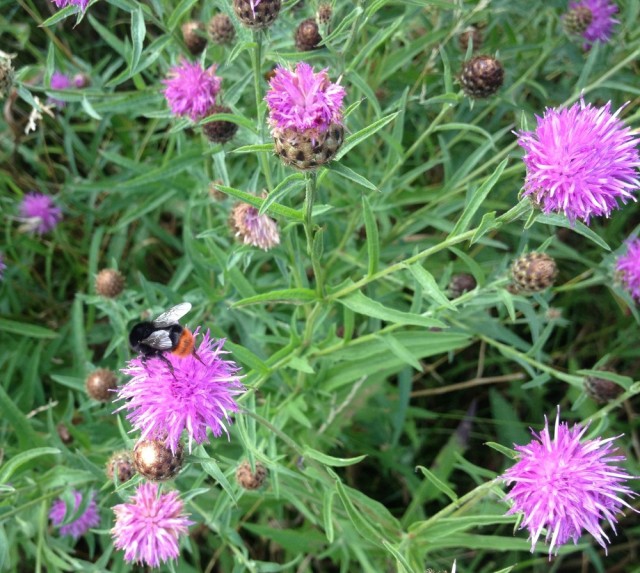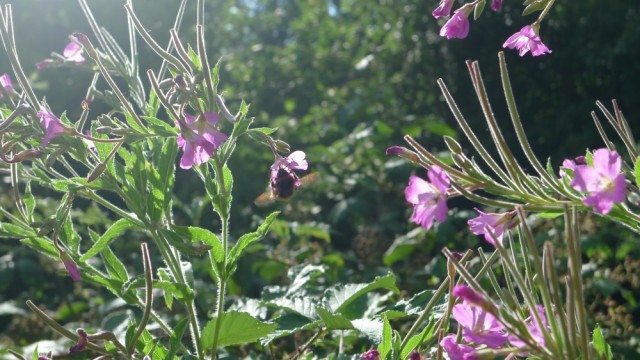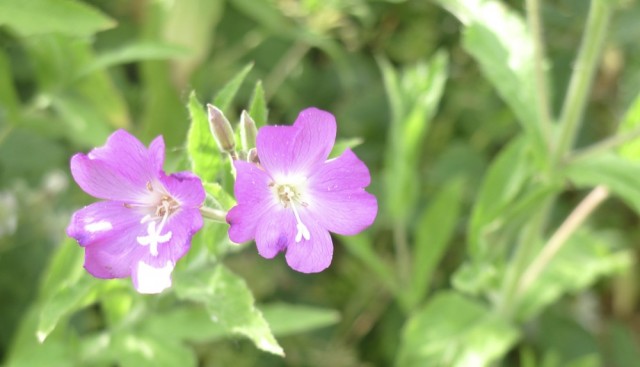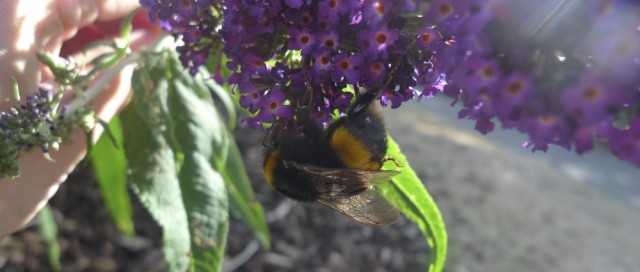For the last few weeks it feels like I have been living in a country that is not England. A dream world where I haven’t needed an umbrella for weeks at a time, where my 7am walk to the bus stop has felt warm enough not to wear a coat, and where sandals and shorts can be worn. Never have I known a summer so hot. I have genuinely enjoyed the heat, but I did want rain to come for the sake of the plants, and for the bees. Eventually the sky burst and the deluges came, bringing some relief to the parched grass.
Late July is a time of yellow, purple and pink, of ragwort, thistles and rose-bay willow herb. The hogweed has shrivelled up into dry seed pods and the bramble flowers are turning into blackberries already, so it’s lucky we have the thistle family.
The internet tells me there are around 20 different species of thistle native to the UK. I certainly can’t identify them, but I can look around and see that the purple spiky flowers in the park come in different shapes and sizes. Theresa at Everyday Nature Trails has done a great post on some different types of thistles: Pretty prickly thistles.
I think this type of thistle may be the burdock, the root of which has traditionally been used to make the British drink Dandelion and burdock.
These are tough, sturdy flowers, capable of supporting the weight of the largest bumble bee foragers.
These flowers are daintier and I believe may be creeping thistle, being visited here by a Red-tailed bumblebee, Bombus Lapidarius. Helpful commenters have revealed that these little purple flowers are actually knapweed, part of the same family of plants. Mark says that “Thistles like rich fertile soil whilst knapweed thrives on nutrient poor soil”.
I found a humming field of these knapweeds and ragwort. The yellow and purples together, with red-tailed bumblebees darting everywhere between them, was a marvellous sight.
Ragwort has other common names – ragweed, staggerwort, stinking billy, stinking weed or yellow weed. It can be fatal to some grazing animals, such as horses.
With so many thistles and knapweeds to visit, the rosebay willow herb (fireweed) seemed to be under appreciated this year, but I still observed a few bumbles hanging on to its pretty pink flowers. Mark has left me a comment to say “Your willow herb is actually hairy willow herb and not rosebay willow herb – differences in growing habit and flowers but noticeable hairy leaves and stem”.
Rosebay willow herb itself is a well known bee plant which provides both pollen and nectar, producing very pale, almost water-white honey (info from ‘Twelve months of forage: Plant list for talk’ by Andy Willis, included in Reading Bee Keepers Association’s March 2013 newsletter – scroll right to the end of the newsletter for the forage chart).
Proof that flowers for bees are not tricky to grow. They grow just fine on waste ground and fields, without needing any fertiliser or nurturing. They are just the local wildflowers that spring up in your area, anywhere they can find that’s not concreted or mowed over.
Entranced by the flurrying of bees on thistles, I stayed longer than intended on my walk. I had a lemon and poppyseed cake in the oven, and it was due to come out.
Whilst hurrying back, I had an unexpected encounter. A large bee was crawling slowly across the concrete footpath in the more formal part of the park. I recognised her at once as a Queen buff-tailed bumblebee, her tail a darker buff colour than a worker’s would be.
Concerned for her health, I put my hands down in front of her and she immediately climbed on, as gentle and trusting as could be. I carried her about 100m to a buddleia bush; she eagerly dismounted onto the purple scented flowers and began drinking nectar enthusiastically. Hopefully this helped her regain enough energy to fly. A lovely meeting – and my cake was fine when I got home too.











I, too, have noticed that the honeybees are ignoring the rosebay willowherb on my allotment but are going mad on the borage. There are lots of bumbles around too, some of which are on the willow herb as well as the borage. My echinops sphaerocephalus is just coming out and bumbles love that. I counted 6 species on it last year.
LikeLike
Wish I had some borage nearby to watch. I found some whilst on holiday on Italy and it was very exciting to see all the bee visitors enjoying themselves.
LikeLike
Enjoying the pictures but think your Red Tailed Bumblebees are working Knapweed
LikeLike
Thanks Jonathan, I’ve updated my post to say knapweed now. My flower ID skills are not good, so I need the help of commenters such as yourself!
LikeLike
I greatly admire you for having a go at identifying them which is the fastest way to learn. Most are too afraid to put their head above the parapet and so remain ignorant of the wonders around us.
After half a century keeping bees I am still learning about these amazing creatures and their relationship with flowers and fertilisation.Their language and navigation information ability appears to be superior to most other creatures.
Who else can find food 3 miles away return with a tasting sample,do a dance in the dark telling others what it is,where it is correct to a few feet and how much honey to load up from stores to get there and run out(so as to maximise return payload). This also allows for direction and movement of the sun and head and tail winds,before sending 1000 others off 3 miles to get the food.It has to be right information or no increase to the hive.
Keep on bumbling!
LikeLike
Half a century! That beats anyone I’ve ever met. You’re right, they are remarkable creatures and scientists seem to still be discovering fascinating new bee facts.
LikeLike
I love your what’s flowering posts!!! I can confirm the burdock, and Jonathan’s centaurea suspicion.
LikeLike
Thanks 🙂 Good to have your confirmation, I’ve updated the post now.
LikeLike
A beautiful post. A red-tailed Bumblebee is a first for me! Thank you.
LikeLike
They may be a UK species only? They’re very cute.
LikeLike
Just checked up on their distribution and they’re Europe and North Africa only 🙂
LikeLike
Well I guess I need to travel more!
LikeLike
Emily, how was the lemon and poppyseed cake?!
LikeLike
Ah, the all important question! I was pleased with it, the Hummingbird Bakery book has come through for me each time so far. Very moist, or as my soon-to-be Scottish mother-in-law said, sapsy.
LikeLike
Jonathan is correct they are Knapweed not thistles, though look similar and are part of same family of plants. Your willow herb is actually hairy willow herb and not rosebay willow herb – differences in growing habit and flowers but noticeable hairy leaves and stem.
Thistles like rich fertile soil whilst knapweed thrives on nutrient poor soil.
LikeLike
Thanks Mark, I continue to admire your flower knowledge.
LikeLike
Those red-tailed bumblebees are gorgeous. I haven’t seen them around here. Both the bumbles and the honey bees are working the borage like crazy, even in the evening after sundown. I’m glad it grows wild here along with that pretty yellow blossom, Bird’s Foot Trefoil.
I wish I knew my bumbles as well as you do.
LikeLike
Knowing bumbles isn’t hard here – there are six very common species, of which I only regularly see about three or four in London. Lucky you having borage about.
LikeLike
Borage is one of the most nectafarious plants there is, refilling in only 40 minutes and the bees love it (taken from the excellent book, A Sting in the Tail by Dave Goulson bee prof.)
LikeLike
Fantastic. We need more borage about, it’s such a pretty flower too.
LikeLike
Poor old buff-tailed queen – it must be exhausting working in that heavy fur coat in the heat. Hope she was OK – it looks lovely and wild-flowery in your part of the country at the moment. Ragwort & thistles are great for butterflies too. Do you have any cinnabar moth caterpillars on the ragwort?
LikeLike
So that’s what those caterpillars I saw were… I tried to take a photo but it came out blurry. What a pretty moth to turn into!
LikeLike
I don’t know the difference between the native thistles either, and I should really learn because the bees love them so much. This really is an argument for not tidying up wild areas. The Ragwort in the fields in this area is removed at once because of the fears of harm to horses – and yet it’s so good for insects.
LikeLike
Yes, sometimes people think trimming everything and having neat and tidy areas is best, but wildlife likes messy. There’s no horses in our park, so the ragwort is fine.
LikeLike
Interesting: all the flowers with bees are pink or purple… none on the yellow ones?
LikeLike
I seem to remember I tried to get some on the ragwort but the bees were moving too quickly, some flowers they stay on longer than others. The time of day can influence how popular a flower is too, some flowers release nectar in the morning and others the afternoon or evening.
LikeLike
How wonderful is that, that you got to rescue a bee queen? Very cool. I love those big, fat-looking bumble bees (like the one in your pic) that are so loud when they fly. They look so furry and so friendly!
LikeLike
It was a special moment. Bumblebee stings are supposed to be very painful, but they’re such gentle creatures that they’re only likely to sting if you do something like step on them.
LikeLike
Great post with great photos. I walked past a whole section over grown with burdock in a local park last week and it was buzzing with loads of different bumble bees and some honey bees! I think I will have to go back for some seed for my guerrilla planting project!
LikeLike
Good old burdock! Great for bees and makes a tasty drink too. Like the sound of your guerrilla planting project!
LikeLike
I’m always jealous of your bumble encounters. The Texas species are not nearly as adorable.
LikeLike
That’s a shame. I saw some pretty bumbles while I was in California, maybe you need to move to the West coast!
LikeLike
Great flowering fields there for shooting the creatures at this time of year.
LikeLike
They are, I’m really lucky to live so close to them.
LikeLike
I wonder if your bumble bee queen would go on to try and start a second nest this year or whether she was just stocking up on supplies to go into her winter rest? I’m sure we have two cycles for some of the bumble bees over here. This year there have fewer bumble bees around than usual in my garden and round about.
LikeLike
I had assumed she was getting ready to hibernate, but your idea is intriguing. I think I read somewhere that some of the earlier emerging bees here can fit in two cycles.
LikeLike
Thanks for a really interesting post and nice photos. I tried shop bought seed mix for bees which unfortunately must have produced nothing more than dust! But I think planting a few proper bee-attracting flowers in the garden makes a huge difference especially varieties which keep the bee season going for longer. Yes, the weather has been amazingly hot recently – enjoy it while it lasts!
LikeLike
Thanks 🙂 A shame that the shop bee mix didn’t work…. the London Beekeepers Association sell a seed mix for bees: http://www.lbka.org.uk/seed_shop.html. Perhaps the type of soil you have matters, I’m sure the LBKA Forage Officer Mark Patterson would be able to advise you on that, as he’s a gardener.
LikeLike
Thanks Emily, that’s really helpful – I’ll definitely look into that!
LikeLike
Nice . . . both the write-up and the photos.
And what tale will the queen recount of the giant who helped her in her time of need.
LikeLike
Thanks. That would be the first time I’ve been referred to as a giant 🙂
LikeLike